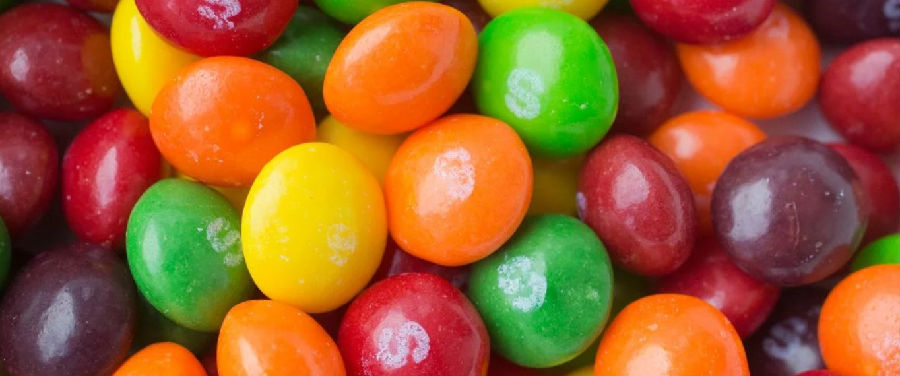Why it can be hard to stop eating even when you're full
дёәд»Җд№Ҳе·Із»ҸеҗғеҲ°ж’‘дҪҶеҳҙе·ҙиҝҳжҳҜеҒңдёҚдёӢжқҘ
All foods are not created equal. Most are palatable, or tasty to eat, which is important because we need to eat to survive. For example, a fresh apple is palatable to most people and provides vital nutrients and calories.
并йқһжүҖжңүйЈҹзү©йғҪжҳҜз”ҹжқҘе№ізӯүзҡ„гҖӮеӨ§еӨҡж•°йЈҹзү©йғҪзҫҺе‘іеҸҜеҸЈпјҢиҝҷдёҖзӮ№еҚҒеҲҶйҮҚиҰҒпјҢеӣ дёәдәәйңҖиҰҒеҗғдёңиҘҝжүҚиғҪжҙ»дёӢеҺ»гҖӮдҫӢеҰӮпјҢеҜ№дәҺеӨ§еӨҡж•°дәәиҖҢиЁҖпјҢдёҖйў—ж–°йІңзҡ„иӢ№жһңдёҚд»…жұҒеӨҡе‘ізҫҺпјҢиҖҢдё”иҝҳиғҪжҸҗдҫӣйҮҚиҰҒзҡ„иҗҘе…»зҙ е’ҢеҚЎи·ҜйҮҢгҖӮ
But certain foods, such as pizza, potato chips and chocolate chip cookies, are almost irresistible. They're always in demand at parties, and they're easy to keep eating, even when we are full. In these foods, a synergy between key ingredients can create an artificially enhanced palatability experience. Researchers call this hyperpalatability. Eaters call it delicious.
дҪҶжҹҗдәӣйЈҹзү©пјҢдҫӢеҰӮжҠ«иҗЁгҖҒи–ҜзүҮе’Ңе·§е…ӢеҠӣжӣІеҘҮйҘје№ІпјҢеҚҙд»Өдәәж— жі•жҠ—жӢ’гҖӮиҒҡдјҡж—¶жҖ»иғҪзңӢеҲ°е®ғ们зҡ„иә«еҪұпјҢиҖҢдё”еҚідҫҝеңЁе·Із»Ҹеҗғж’‘зҡ„жғ…еҶөдёӢпјҢд№ҹиҝҳиғҪеҶҚеҗғдёҖзӮ№гҖӮеңЁиҝҷдәӣйЈҹзү©дёӯпјҢе…ій”®жҲҗеҲҶй—ҙзҡ„еҚҸеҗҢдҪңз”ЁеҸҜеҲӣйҖ еҮәдёҖз§Қдәәдёәеўһејәзҡ„еҸЈж„ҹгҖӮз ”з©¶е‘ҳе°Ҷе…¶з§°дёәи¶…зҫҺе‘іжҖ§пјҢеӨ§иғғзҺӢз§°е…¶дёәзҫҺе‘іеҸҜеҸЈгҖӮ
Initial studies suggest that foods with two or more key ingredients linked to palatability вҖ” specifically, sugar, salt, fat or carbohydrates вҖ” can activate brain-reward neurocircuits similarly to drugs like cocaine or opioids. They may also be able to bypass mechanisms in our bodies that make us feel full and tell us to stop eating.
еҲқжӯҘз ”з©¶иЎЁжҳҺпјҢеҗ«жңүдёӨз§ҚжҲ–еӨҡз§Қи°ғе‘іжҲҗеҲҶпјҲзү№еҲ«жҳҜзі–гҖҒзӣҗгҖҒи„ӮиӮӘжҲ–зўіж°ҙеҢ–еҗҲзү©пјүзҡ„йЈҹзү©еҸҜжҝҖжҙ»еӨ§и„‘зҡ„еҘ–еҠұзҘһз»Ҹеӣһи·ҜпјҲдёҺеҸҜеҚЎеӣ жҲ–йҳҝзүҮзұ»иҚҜзү©зҡ„дҪңз”Ёзұ»дјјпјүгҖӮиҝҷдәӣйЈҹзү©жҲ–и®ёиҝҳиғҪйҒҝејҖжҲ‘们зҡ„иә«дҪ“жңәеҲ¶пјҢиҖҢиҝҷз§ҚжңәеҲ¶дјҡжҸҗйҶ’жҲ‘们йҘұи…№пјҢдёҚйңҖиҰҒеҶҚеәҰиҝӣйЈҹгҖӮ

Our research focuses on rewarding foods, addictive behaviors and obesity. We recently published a study with nutritional scientist Debra Sullivan that identifies three clusters of key ingredients that can make foods hyperpalatable. Using those definitions, we estimated that nearly two-thirds of foods widely consumed in the U.S. fall into at least one of those three groups. Foods that are easily accessible and cheap are everywhere in our society. Unsurprisingly, eating them has been associated with obesity.
жҲ‘们зҡ„з ”з©¶йӣҶдёӯе…іжіЁеҘ–еҠұйЈҹзү©гҖҒжҲҗзҳҫиЎҢдёәе’ҢиӮҘиғ–гҖӮиҝ‘жңҹпјҢжҲ‘们дёҺиҗҘе…»еӯҰ家й»ӣеёғжӢүВ·жІҷеҲ©ж–ҮпјҲDebra SullivanпјүеҗҲдҪңеҸ‘иЎЁдәҶдёҖйЎ№з ”з©¶пјҢзЎ®е®ҡдәҶдҪҝйЈҹзү©еҸҳеҫ—и¶…зә§зҫҺе‘ізҡ„дёүзұ»е…ій”®жҲҗеҲҶгҖӮйҖҡиҝҮе®ҡд№үпјҢжҲ‘们估计全зҫҺдёүеҲҶд№ӢдәҢзҡ„зҫҺйЈҹйғҪеңЁиҝҷдёүзұ»жҲҗеҲҶд№ӢеҲ—гҖӮдҫҝе®ңжҳ“д№°зҡ„йЈҹзү©еҲ°еӨ„йғҪжҳҜпјҢиҖҢйЈҹз”ЁиҝҷдәӣйЈҹзү©дёҺиӮҘиғ–жңүе…ід№ҹе°ұдёҚи¶ідёәеҘҮдәҶгҖӮ
Documentaries in the last 15-20 years have reported that food companies have developed formulas to make palatable foods so enticing. However, manufacturers typically guard their recipes as trade secrets, so academic scientists can't study them. Instead, researchers have used descriptive definitions to capture what makes some foods hyperpalatable. For example, in his 2012 book, David Kessler, former Commissioner of the U.S. Food and Drug Administration (FDA), wrote:
иҝҮеҺ»15иҮі20е№ҙзҡ„зәӘеҪ•зүҮжҠҘйҒ“пјҢйЈҹе“Ғе…¬еҸёе·Із ”еҸ‘еҮәдҪҝзҫҺе‘ійЈҹе“ҒеҸҳеҫ—иҜұдәәзҡ„й…Қж–№гҖӮдҪҶйҖҡеёёжғ…еҶөдёӢпјҢеҲ¶йҖ е•Ҷдјҡе°Ҷиҝҷдәӣй…Қж–№и§ҶдҪңе•ҶдёҡжңәеҜҶеҠ д»ҘдҝқжҠӨпјҢеӣ жӯӨеӯҰжңҜ科еӯҰе®¶ж— жі•еҜ№е…¶еұ•ејҖз ”з©¶гҖӮеӣ жӯӨпјҢз ”з©¶е‘ҳж №жҚ®иҝҷдәӣжҸҸиҝ°жҖ§е®ҡд№үжқҘжҺўз©¶йЈҹзү©еҸЈж„ҹи¶…иөһзҡ„еҺҹеӣ гҖӮдҫӢеҰӮпјҢ2012е№ҙпјҢзҫҺйЈҹе“ҒиҚҜе“Ғзӣ‘з®ЎеұҖпјҲFDAпјүеүҚдё“е‘ҳжҲҙз»ҙВ·еҮҜж–ҜеӢ’пјҲDavid KesslerпјүеңЁе…¶и‘—дҪңдёӯеҶҷйҒ“пјҡ
"What are these foods? .... Some are sweetened drinks, chips, cookies, candy, and other snack foods. Then, of course, there are fast food meals вҖ” fried chicken, pizza, burgers, and fries."
вҖңе“ӘдәӣйЈҹзү©еұһдәҺиҝҷдёҖиҢғз•ҙе‘ўвҖҰвҖҰгҖӮеҗ«зі–йҘ®ж–ҷгҖҒи–ҜжқЎгҖҒйҘје№ІгҖҒзі–жһңе’Ңе…¶е®ғдј‘й—ІйЈҹе“ҒгҖӮеҪ“然пјҢеҝ«йӨҗйЈҹе“ҒвҖ”зӮёйёЎгҖҒжҠ«иҗЁгҖҒжұүе Ўе’Ңи–ҜжқЎйғҪеұһдәҺиҝҷзұ»йЈҹзү©гҖӮвҖқ
иҜ‘ж–ҮеұһеҸҜеҸҜеҺҹеҲӣпјҢд»…дҫӣеӯҰд№ дәӨжөҒдҪҝз”ЁпјҢжңӘз»Ҹи®ёеҸҜиҜ·еӢҝиҪ¬иҪҪ












